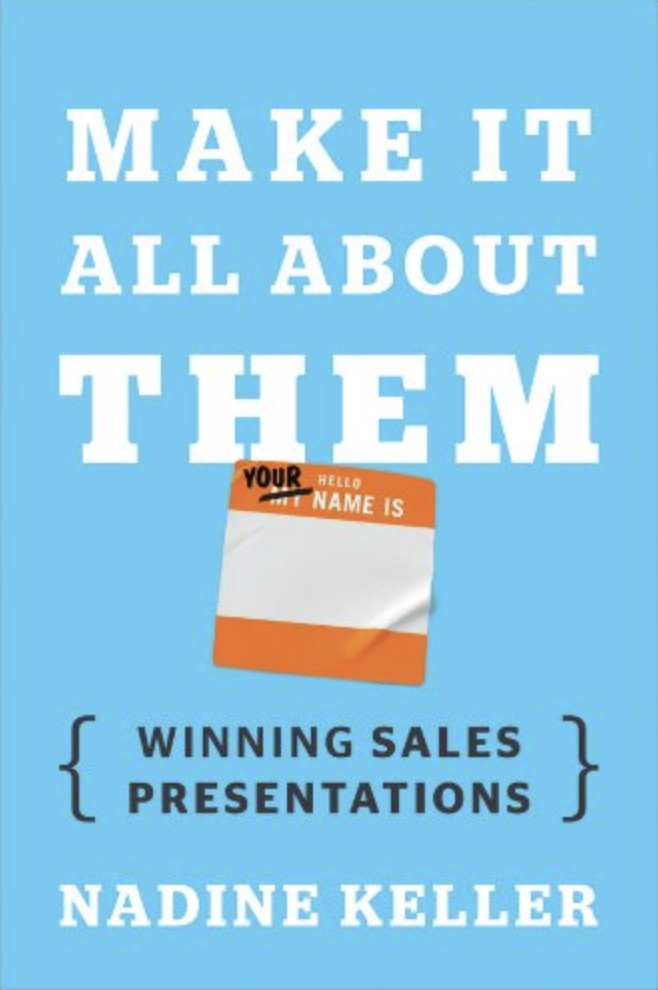Key Quote:
“A sales presentation that is all about the product and the vendor is a big bore. A sales presentation that focuses on the audience and their problems, on the other hand, is engaging.” (p. 3) — Nadine Keller
Key Points:
What You Present: The Messages. Clients need to be heard and they, not you, should be the “center of the story” (p. 3). Lead with how you will meet their needs and simplify your message. Develop a “stake in the ground” story that underscores what they need and what you provide, and that is easily remembered and shared (p. 24).
The Skill: How You Say It. A skilled facilitator can bring warmth and authenticity to a presentation, express relevant experience, and advocate for the client. All the presenters should speak in “plain old English” rather than business jargon and acronyms. Presenters should also evaluate the audience’s response in order to keep their attention and use concrete language that communicates “compelling benefits” (p. 59). “Gather intelligence” about members of the client audience when you prepare, role play before your presentation by answering anticipated questions, and listen carefully to questioners during the presentation (p. 130). Finally, make sure your own team behaviors read well.
The Materials: What We Say It With. The presentation and the presentation deck are not synonymous. Consider the message sent by the design as well as the content of the deck, keep the clutter of information down, and make sure each slide makes one simple point. Consider using audio as well as video in presentations.
Key Concepts:
Designing Client Experience
In developing your sales presentation, keep the client and their needs top of mind as you prepare for each of the three key aspects (message, skills, materials).
The authors of the book The Experience Economy discuss experience: “While commodities are fungible, goods tangible, and services intangible, experiences are memorable.” The authors go on to share an example, explaining that “most parents don’t take their kids to Walt Disney World just for the event itself, but rather to make that shared experience part of everyday family conversations for months, even years, afterward. They explain, ‘While the experience itself lacks the tangibility, people greatly value the offering because its value lies within them,
where it remains long afterward’” (p. xiii).
In one example of crafting a good sales experience, Prudential’s Linda Knox paid attention to the client’s experience at the company by the way she staged the office space. The office was renovated to resemble a living room to make clients feel comfortable and at ease.
The Rule of Three and Telling a Story
The human brain is programmed to “easily remember groups of three” (p. 13). Before crafting your PowerPoint, discuss with your team the client’s needs, your strengths, and your competitor’s strengths and weaknesses, then craft three basic messages to send in your presentation.
These three messages are a “guide to determine what to include – and, most important, what to exclude – from your presentation” (p. 19).
As you craft your presentation, think of it as a story more than a sales pitch.
“There is the story that you tell the marketplace about who your company is. There are the stories you craft for the specific clients to whom you are presenting. And there are the stories within the story, which bring what you do to life and [make] it memorable for the client” (pp. 21-22)
Creating Connection in Presentations
In a pitch situation, the incumbent vendor has the advantage of being able to remind the client of their existing relationship. Keller describes a sales team that sent a note to clients the day before a pitch to let them know how much they value the relationship (p. 37-38).
[It is also worth noting that this is also an example of surrounding face-to-face contact with other media. Not only is the message beneficial, but the team also gives themselves the advantage of more frequency of contact with the clients.]
Keller tells another success story to illustrate how to create a connection during the client experience. All the team members of a packaged food company had a line under their email signatures that told what their favorite product from the company was. The sales team decided to play off that in their presentation by each bringing a box or can of their favorite product, and, after introducing themselves, they explained why a certain product was their favorite. For example, one sales team member loved the popcorn because it reminded him of movie night with his kids. The introduction created a conversation and connection with the client’s team, who, unprompted, shared their own favorite product in their introductions. The clients actually hugged the sales team as they left the room (p. 51).
Layering consistent messaging makes your communication more powerful. Keller’s description of Land Rover dealerships highlights the importance of a consistent message and client experience. All dealerships are located on the top of rocky hills to signify a sense of adventure. All cars come with a compass, trail mix, and journal. Selling an experience is more than merely selling a product.
Handling Questions and Answers
Prepare for presentations by researching clients, anticipating what questions will be asked, and role-playing how you will answer them.
A sales mistake that is not commonly discussed is answering a question with too much information. A quick way to kill client engagement is to answer their question with a 15-minute diatribe. For example, they ask for the time and, to answer them, you make them watch you build a watch.
Don’t be afraid to not know an answer. Not knowing the answer to a question is an excellent opportunity to ask for a follow-up conversation.
The Coaching Process
Keller provides some questions to guide the coaching process as you work with your own sales team:
• “Will the desired change have an impact on this person’s performance in this deal?”
• “Is this something that the person can reasonably change?”
• “Is it realistic that this person can make this behavior change in the time until the next presentation?” (p. 109)
Of Note
“Big and open” postures give off an air of power and confidence and also make you feel powerful and confident (p. 114). Studies show that people who adopt this kind of “power pose” – even for 2 minutes – become more risk tolerant and experience a measurable increase in testosterone and a decrease in cortisol (the stress hormone).
“Myth: People buy benefits. Truth: People buy compelling benefits” (p. 71).
“Myth: The deck is the presentation. Truth: You are the presentation” (p. 133).
Finally, don’t forget the people who don’t attend the presentation. Develop something to be shared with them, too.
Keller, N. (2013). Make It All About Them: Winning Sales Presentations. New York: John Wiley and Sons.

Prepare for presentations by researching clients, anticipating what questions will be asked, and role-playing how you will answer them.
A sales mistake that is not commonly discussed is answering a question with too much information. A quick way to kill client engagement is to answer their question with a 15-minute diatribe.
